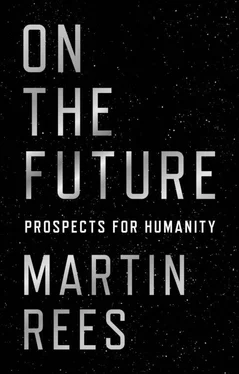I thought of the long ages of the past during which the successive generations of these things of beauty had run their course… with no intelligent eye to gaze upon their loveliness, to all appearances such a wanton waste of beauty…. This consideration must surely tell us that all living things were not made for man…. Their happiness and enjoyments, their loves and hates, their struggles for existence, their vigorous life and early death, would seem to be immediately related to their own well-being and perpetuation alone. [12]
The papal encyclical eased the path to agreement at the Paris climate conference in December 2015. It eloquently proclaimed that our responsibility—to our children, to the poorest, and to our stewardship of life’s diversity—demands that we don’t leave a depleted and hazardous world.
We all surely hold these sentiments. But our secular institutions—economic and political—don’t plan far enough ahead. I’ll return in my final chapters to address the daunting challenges to science and to governance that these threats pose.
Regulations can help. But regulations won’t gain traction unless the public mind-set changes. Attitudes in the West to, for instance, smoking and driving drunk have transformed in recent decades. We need a similar change in attitude so that manifestly excessive consumption and waste of materials and energy—4 × 4 SUVs (disparaged as Chelsea tractors in London, where they clog the streets in up-market districts), patio heaters, brightly illuminated houses, elaborate plastic wrappings, slavish following of fast-changing fashions, and the like—become perceived as ‘tacky’ rather than stylish. Indeed, a trend away from excessive consumption may happen without exterior pressure. For my generation, our living space (a student room and later something more spacious) was ‘personalised’ by books, CDs, and pictures. Now that books and music can be accessed online, we will perhaps become less sentimental about ‘home’. We will become nomadic—especially as more business and socialising can be done online. Consumerism could be replaced by a ‘sharing economy’. If this scenario transpires, it will be crucial that developing nations transition directly towards this lifestyle, bypassing the high-energy, high-consumption stage through which Europe and the United States have passed.
Effective campaigns need to be associated with a memorable logo. The BBC’s 2017 TV series Blue Planet II showed an albatross returning from wandering thousands of miles foraging in the southern oceans—and regurgitating for its young not the craved-for nutritious fish, but bits of plastic. Such an image publicises and motivates the case for recycling plastics, which otherwise accumulate in the oceans (and the food chains of the creatures that live there). Likewise, the longtime iconic image (albeit somewhat misleading) showing a polar bear clinging to a melting ice floe is emblematic of the climate change crisis—my next topic.
The world will get more crowded. And there’s a second prediction: it will gradually get warmer. Pressures on food supplies, and on the entire biosphere, will be aggravated by the consequent changes in global weather patterns. Climate change exemplifies the tension between the science, the public, and the politicians. In contrast to population issues, it is certainly not underdiscussed—despite the fact that in 2017 the Trump regime in the United States banned the terms ‘global warming’ and ‘climate change’ from public documents. But the implications of climate change are dismayingly under-acted-on.
One thing is not controversial. The concentration of CO 2in the air is rising, mainly due to the burning of fossil fuels. The scientist Charles Keeling measured CO 2levels using an instrument at the Mauna Loa Observatory in Hawai‘i, which has been operating continuously since 1958 (following Keeling’s death in 2005 the programme is being continued by his son, Ralph). And it is not controversial that this rise leads to a ‘greenhouse effect’. The sunlight that heats the Earth is reemitted as infrared radiation. But just as the glass in a greenhouse traps the infrared radiation (though it lets the light in) the CO 2likewise acts as a blanket that traps heat in the Earth’s atmosphere, land masses, and oceans. This has been understood since the nineteenth century. A rise in CO 2will induce a long-term warming trend, superimposed on all the other complicated effects that make climate fluctuate.
Doubling of CO 2, if all other aspects of the atmosphere were unchanged, would cause 1.2 degrees (centigrade) of warming, averaged over the Earth—this is a straightforward calculation. But what is less well understood are associated changes in water vapour, cloud cover, and ocean circulation. We don’t know how important these feedback processes are. The fifth report from the Intergovernmental Panel on Climate Change (IPCC), published in 2013, presented a spread of projections, from which (despite the uncertainties) some things are clear. In particular, if annual CO 2emissions continue to rise unchecked we risk triggering drastic climate change—leading to devastating scenarios resonating centuries ahead, including the initiation of irreversible melting of ice in Greenland and Antarctica, which would eventually raise sea levels by many metres. It’s important to note that the ‘headline figure’ of a global temperature increase is just an average; what makes the effect more disruptive is that the rise is faster in some regions and can trigger drastic shifts in regional weather patterns.
The climate debate has been marred by too much blurring between science, politics, and commercial interests. Those who don’t like the implications of the IPCC projections have rubbished the science rather than calling for better science. The debate would be more constructive if those who oppose current policies recognise the imperative to refine and firm up the predictions—not just globally but, even more important, for individual regions. Scientists in Cambridge and California [13]are pursuing a so-called Vital Signs project, which aims to use massive amounts of climatic and environmental data to find which local trends (droughts, heat waves, and such) are the most direct correlates of the mean temperature rise. This could offer politicians something more relevant and easier to appreciate than a mean global warming.
The build-up rate of CO 2in the atmosphere will depend on future population trends and the extent of the world’s continuing dependence on fossil fuels. But even for a specific scenario for CO 2emission, we can’t predict how fast the mean temperature will rise, because of the ‘climate sensitivity factor’ due to uncertain feedback. The consensus of the IPCC experts was that business as usual, with a rising population and continuing dependence on fossil fuels, has a 5 percent chance of triggering more than six degrees warming in the next century. If we think of current expenditure on cutting CO 2emissions as an insurance policy, the main justification is to avoid the small chance of something really catastrophic (as a rise of six degrees would be) rather than the 50 percent chance of something seriously damaging but which could be adapted to.
The goal proclaimed at the Paris conference was to prevent the mean temperature rise from exceeding two degrees—and if possible to constrain it to 1.5 degrees. This is an appropriate goal if we are to reduce the risk of crossing dangerous ‘tipping points’. But the question is: how to implement it? The amount of CO 2that can be released without violating this limit is uncertain by a factor of two, simply because of the unknown climate sensitivity factor. The target is therefore an unsatisfactory one—and will obviously encourage fossil fuel interests to ‘promote’ scientific findings that predict low sensitivity.
Читать дальше


![Мартин Рис - Всего шесть чисел. Главные силы, формирующие Вселенную [litres]](/books/414169/martin-ris-vsego-shest-chisel-glavnye-sily-formir-thumb.webp)









